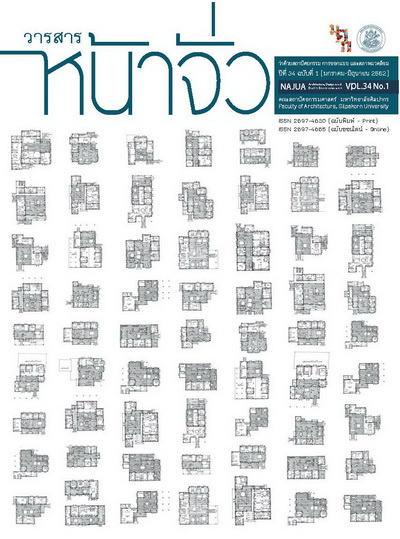Vernacular in Contemporary Design: Intermediary space
Keywords:
Vernacular house, Intermediary space, Interior-Exterior, ContemporaryAbstract
Vernacular in Contemporary Design: Intermediary space
Janeyut Lorchai
Doctor of Philosophy Program in Vernacular Architecture, Faculty of Architecture, Silpakorn University
Veera Inpantang
Faculty of Architecture, Silpakorn University
Folk vernacular house has been built related to location context, harmonious with the surrounding nature and suitable for functional activities. Distinctive character of the house that conform with the environment and way of life is an intermediate space. It is a significant area to create connection between interior space and exterior environment according to the level of enclosure, in determining the living interaction patterns due to natural factors and sociocultural system.
This article aims to describe the relationship of three parts: 1) The vernacular in folk house; 2) Concepts and theories concerning the intermediate space; and 3) Creative approach from vernacular to contemporary design. A conceptual framework is set for the development of wisdom creation of intermediate space characteristics from folk vernacular house to contemporary design. The conclusions draw the criteria for consideration on function/activities, level of privacy and relationship to the external environment.
Finally, in analysis the case study with such criteria, the result shows that conceptual framework can be applied to contemporary house design in different contexts, creating architecture that suitable for a place in the present situation as well as in the past.
References
- Horayangura W., Settaworakit B., and Inpuntang V. (2015). phư̄ nthān ʻēkkalak sathāpattayakam Thai. (In Thai). [Fundamentals of Thai architectural identity]. BKK. JBP Center.
- Horayangura W., (1993). phatthanākān nǣo khwāmkhit læ rūpbǣp khō̜ng ngān sathāpattayakam ʻadı̄t patčhuban ʻanākhot. (In Thai). [Development of Concept and Architectural Style, Past, Present and Future]. BKK. The Association of Siamese Architects Under Royal Patronage.
- Inpuntang V., yaorư̄ an phư̄ nbān yān tawantok. (In Thai). [Vernacular house in the western region]. BKK: Faculty of Architecture, Silpakorn University.
- Chungsiriarak. S., (2010). sathāpattayakam bǣp tawantok nai Sayām samai ratchakān thı̄ sı̄ - Phō̜.Sō̜ - 2480. (In Thai). [Western Style Architechitecture in Siam During King Rama IV-1937]. BKK: Faculty of Architecture, Silpakorn University.
- Panin O., (1995). thı̄ wāng thāng sathāpattayakam. (In Thai). [Architecural Space]. Patumthani: Rangsit University.
- Panin O., (2000). panyāsa rāng san nai rư̄ an phư̄ n thin ʻusākhanē kō̜ranı̄ sưksā Thai Lāo ʻindōnı̄sı̄a Filippin phān thı̄ wāng mūan læ chı̄wit. (In Thai). [Creativity in Vernacular House in Thai, Laos, Indonesia, Philippine: Space, Volume and life]. BKK: J Print.
- Panin O., Thaveeprungsriporn P., and Tachakitkachorn T. (2003). phūmpanyā sathā pattayakam. (In Thai). [Architeural Wisdom]. BKK: Faculty of Architecture, Chulalongkorn University.
- Panin O., and other. khwāmlāklāi khō̜ng rư̄ an phư̄ n thin Thai. (In Thai). [Diversity of Thai Vernacular]. BKK: Faculty of Architecture, Silpakorn University.
- Ching, Frank. (2007). 1943-Architecture: Form, Space & Order. New Jersey: John Wiley & Sons.
- Kisho Kurokawa. (1988). Rediscovering Japanese space. New York: Weatherhill.
- Kisho Kurokawa. (n.d.). Intermediary Space. Accessed March 7, 2017. Available from http://www.kisho.co.jp/page/305.html
- Yoshinobu Ashihara. (1970). Exterior design in architecture. New York: Van Nostrand Reinhold.





